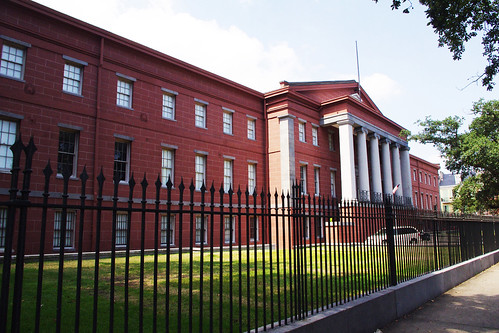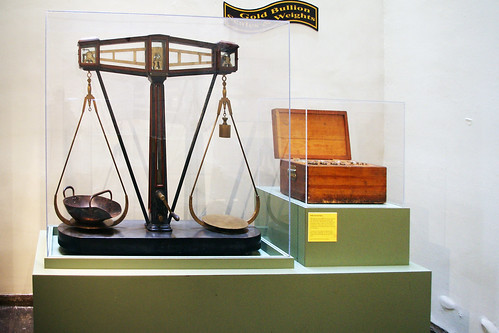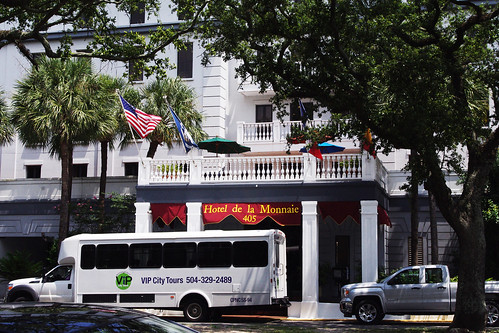
PREV ARTICLE
NEXT ARTICLE
FULL ISSUE
PREV FULL ISSUE
HOWARD BERLIN VISITS THE NEW ORLEANS MINT
Numismatourist Howard Berlin is often off in some foreign land, but this month he visited a stateside attraction. Here's his account of a recent visit to the old mint building in New Orleans, LA.
-Editor
I was in Rosemont for the ANA and almost a few days later after returning home, my wife and I were on the plane for New Orleans. It’s nice being retired to travel a lot while trying to spend down our three childrens’ inheritances. I was last in the Big Easy 40 years ago and we had planned many of the things most tourists do. However one stop I wanted to make was to see the museum of the United States Mint, which opened in 1981 with some closures for renovations. Also the admission price was right – free. Even though I had not seen the Mint museum before, I have three pages in my Numismatourist book about the Mint with pictures provided by the museum. It is said a picture is supposedly worth a thousand words. However, nothing beats seeing things in person, especially when it relates to numismatics. While on a hop-on-hop-off tour of the city, we got off at the French Market, which was block behind the Mint building on Esplanade Avenue. Also of interest, across the street from the mint is the Hotel de la Monnaie – The Mint Hotel. The Mint was built in 1835, with the first coins struck in 1838 and minting operations ceased in 1909. It is the oldest surviving structure to have served as a U.S. Mint. It also holds the distinction of being the only mint to have produced both American and Confederate coinage. In 1975, the New Orleans Mint was designated a National Historic Landmark by the National Park Service. When Louisiana seceded from the Union in 1861, the Mint struck coins for the Confederacy for less than one month, as it quickly ran out of bullion. On display on loan from the American Numismatic Society, is one of a few remaining silver 1861-O seated liberty half dollars. As many collectors of U.S. coins may know, some varieties had very short runs at this Mint, some as little as two years. A few notable coins are the 1838-O silver three-cent silver – the only year a silver three-cent coin was struck by a branch mint and was also the smallest denomination silver coin. The 1838-O and 1839-O 50-cent silver capped bust and quarter eagle gold were the only two years the “O” mint mark appeared on the obverse, the first time that a mintmark appeared on the obverse. The 1854-O $3-gold was the only year the $3-gold piece was struck at the New Orleans Mint. The Mint Museum has a number of interesting exhibits which include coins, machinery, documents, and relics relating to the daily operations of the coining department. A number of coins on display are on loan from the Federal Reserve Bank of Atlanta and a several collectors.

1. The front of the New Orleans Mint, whose free exhibition is on the building’s ground floor.

2. These large scales and weights were used to weigh gold bullion from one thousandth part of a grain to 750 ounces. After the mint closed these were shipped to the Atlanta Federal Reserve Bank, which opened in 1914.These are similar to those still used by the Federal Reserve Banks of New York and San Francisco.

3. This is probably a presentation ingot, weighing 8.85 ounces and .999 fine. Its dimensions, weight, and fineness are not the same as for standard coining ingots of 10 percent copper and shaped into 12-3/8” x 1-5/8” x ½” bricks.

4. The appropriately named Hotel de la Monnaie (Mint Hotel) is located across the street from the Mint.
The Numismatic Bibliomania Society is a non-profit organization promoting numismatic literature. See our web site at coinbooks.org. To submit items for publication in The E-Sylum, write to the Editor at this address: whomren@gmail.com To subscribe go to: https://my.binhost.com/lists/listinfo/esylum All Rights Reserved. NBS Home Page Contact the NBS webmaster 
|